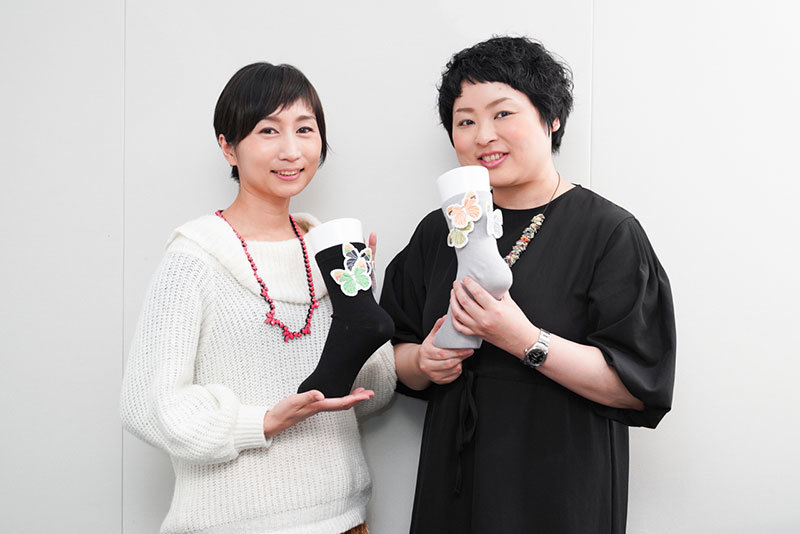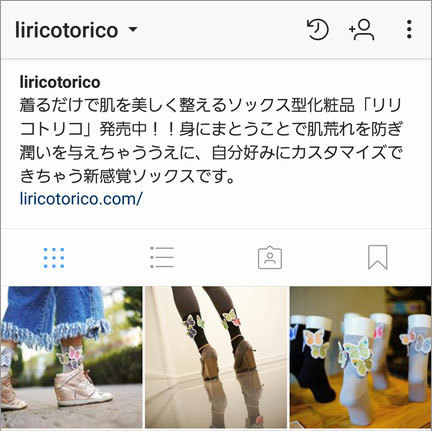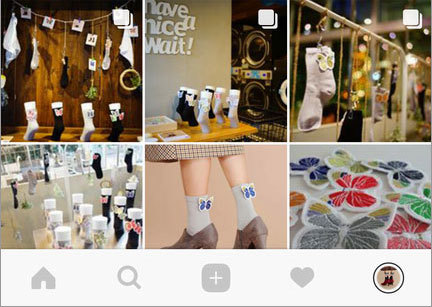Dentsu Inc.'s 'Material Innovation' project discovers unique materials and leverages the creative power of advertising agencies to develop and sell products with new value. As its first initiative, the sock-type cosmetic 'Lirikotriko,' which beautifies skin simply by wearing it, is now on sale.
Just three employees of Dentsu Inc. handled everything from planning and development to PR and sales. Two of them, Mineko Hotta and Yoko Kibata, look back on the project.
We want to spark something new in the world with this fascinating material
Hotta:In my previous column, I wrote about the background and purpose of the "Material Innovation" project. This time, I'd like to look back on the project in a dialogue format with Ms. Kihata, who worked on it with me, sharing a bit more behind-the-scenes insight.
Kihata: Though when I say "look back," it's not over yet (laughs). We're still enthusiastically selling gift sets for White Day!
Hotta: Kihata and I had been talking for quite some time about "doing something innovative, regardless of the field," and we finally made it happen. I think we first discussed it around December 2016?
Kihata: Exactly. Hotta-san told me, "There's this interesting material," and that was Raffinan, the "wearable cosmetics" developed by Teijin Frontier.
Horita: Raffinan was a shock. The fact that it was "cosmetics in fiber" was fascinating, and I thought making apparel with this material could spark something new in the world. Then right away, Kihata-san jumped on it, saying, "With that material, wouldn't it be interesting to make tights?"
Kihata: Well, I just happen to really love tights (laughs), so my first thought was "Tights!" Winter makes your legs dry and flaky, so tights that moisturize your skin just by wearing them? Lots of people would want those.
Hotta: "No hassle with skincare!" "No sticky cream feeling!" "If they're cute tights, it's killing two birds with one stone!" Our imagination just kept running wild.
Kihata: People often ask, "Why would Dentsu Inc. get into product development and sales?" Well, there was Hotta-san's "micro-business" concept, but at the time, I was on secondment to Dentsu ScienceJam Inc. Since "product development that sparks innovation" is one of ScienceJam Inc.'s core themes, it made the pitch much easier.
Hotta: I believed Dentsu Inc.'s creative power could be used for much more than just advertising, and I wanted to build a track record for that. The "Micro Business" concept I wrote about last time and Raffinan were a perfect fit. How did the company react when you pitched this project?
Kibata: My boss was like, "Go for it, go for it." He encouraged us to keep challenging new things, saying he'd support us with budgets and such. That said, Dentsu ScienceJam Inc. typically handles mostly B2B IT products, so we didn't have many B2C products like this.
Hotta: This time, we wanted to show the new value created by adding Dentsu Inc.'s strength in creativity to new functional materials. We really wanted it to be a B2C product accessible to the general public.
Simply attaching a patch to socks changes the product's value.

Mr. Hotta
Hotta: At our first meeting with Teijin Frontier in January 2017, the first thing they said was, "Dentsu Inc., are we talking about advertising?" (laughs). When I said, "We want to make tights with Raffinan," they were really surprised.
Kihata: You wouldn't expect an ad agency to make tights, right? Back then, we didn't fully understand Raffinan's properties, so we made a lot of reckless proposals. Even when they told us, "Raffinan is technically difficult to knit into long yarns, so it's not suitable for tights," we really pushed back, asking, "Can't you make it work?" We finally switched the project to socks in May, right?
Horita: Right. It was a tight deadline—we had to decide immediately to make it in time for the fall/winter sales season, when skin tends to get dry.
Kihata: So we decided, "Let's go with socks!" and development started in earnest, but that's when the real struggle began... In the end, the release date slipped to December.
Hotta: From planning and development to PR, sales, and inventory management—even with Endo Ikumo handling art direction—we pushed forward with just three people. It was a constant struggle.
Kibata: Honestly, from the planning stage onward, it felt like hitting a wall with every single phase we progressed through.
Hotta: We made solid plans, but unexpected things happened. Things like the apparel industry's unique conventions and practices, or guidance and feedback from the Tokyo Metropolitan Pharmaceutical Affairs Division because it's cosmetics... First off, having only two color variations for the socks was the initial unexpected hurdle.
Kihata: Because raffia is hard to dye evenly, any color other than black or gray would end up patchy... When we asked, "Can we knit patterns into them or print designs?" we were told that wasn't possible either. Plain black and gray socks would be boring for young people to buy, so we spent about a month figuring out what to do. Finally, when I happened to visit a sock shop I frequent with Mr. Horita, we saw socks with patches stuck all over them. We looked at each other and thought, "Ah, this could work!"
Hotta: The big thing about patches was that you could personalize them to your taste. Just adding the extra step of "attaching a patch" to plain socks completely transformed the product's value. From there, we brought art director Endo-san into the project and started brainstorming all kinds of designs.
Kibata: At first, the patch motifs were things like flowers, birds, goldfish, mushrooms...
Hotta: Like that surreal one with mushrooms growing out of feet (laughs). And the early designs had a much cuter vibe.
Kihata: We shifted direction to achieve a sharper impression. After much consideration, we settled on butterflies as the motif, aiming for patches that adults could wear stylishly.
Hotta: Endo-san also designed with meticulous attention to detail. He gave precise instructions like, "The choice of thread and stitching technique completely change the expression," and as he did, the ideal form became clearer and clearer.
Kihata: Since the design hinged entirely on the patch, Endo-san's expertise was truly invaluable.
Hotta: He effectively visualized the entire product message for Lilico Torico, including the packaging, cards, and stickers. It was his first time tackling product design, yet he seemed to enjoy it immensely. By the way, Kihata, what was the most enjoyable part for you this time?
Kihata: The moment the actual product we planned and developed arrived was the happiest—or rather, the most shocking. It was like, "We actually made it!" (laughs). Up until then, it had only been a pie in the sky, but suddenly that pie materialized right before our eyes.
Hotta: Really? (laughs) B2C product development is interesting, isn't it?
Kihata: It is! The best part was getting that tangible sense of accomplishment—realizing we could actually create and sell a product all the way to the " " stage.
"Adding emotional value" becomes a new business

Kihata-san
Hotta: This time, as a microbusiness practice, we moved at an incredible pace in a short period. Since it was our first attempt, there were some pretty wild incidents too.
Kihata: Especially the final "We can't sell it!" incident—I can't go into details, but it was shocking (laughs). Still, it was reassuring to have Mr. Hotta calmly handle negotiations during troubles.
Hotta: By the way, during that incident, I negotiated compensation for the delayed delivery by saying, "The sales loss period was X days, so based on the sales plan, we would have expected roughly this much revenue. Please discount that amount."
Kihata: That's Hotta-san's "tenacity" for you... (laughs). We made it to launch safely thanks to Hotta-san's negotiation skills and persistence. Having worked on various product developments before, I really felt I could rely on him.
Hotta: For me, working on compact businesses within my reach was actually easier because the effort required to manage them was also compact.
Kihata: That speed unique to compact operations was refreshing. Normally, when developing a product, you often end up endlessly creating prototypes before commercialization, right?
Hotta: I thought this business model—skipping prototyping and going straight to small-scale, fast, low-cost commercialization—was innovative. You get real feedback by actually selling to users, not just testing hypotheses. And because it's micro-scale, you can try all sorts of challenges you couldn't in a big project.
Kihata: Honestly, it was nothing but challenges! It's rare to experience handling everything ourselves—from planning to sales, promotion, and inventory management—without stopping at just the planning stage.
Horita: This time, we kept costs low by using open services wherever possible, even for setting up the e-commerce site and inventory management. But we also hunted down the cheapest providers for packaging and shipping, crunching the numbers to shave off every last yen. To make it a truly groundbreaking business model, we had to turn a profit – otherwise, it wouldn't mean anything.
Kibata: I think this was a project with the smallest budget, lowest product unit price, and shortest development period in Dentsu Inc.'s history (laughs). But it offered so many lessons you just wouldn't get from larger businesses or typical Dentsu Inc. projects.
Hotta: By experiencing the entire process ourselves, we identified the critical points we absolutely must control. Next time, I believe we can go from planning to launch in a much shorter timeframe. With this know-how, I think we could support large corporations' new business development projects, and eventually, individuals who want to create and sell their own products. As the world's work styles change and side hustles become more common, I'm sure this will fit perfectly.
Kibata: Personally, I'm now eager to try a microbusiness with more industrial products, using molds for manufacturing. Even though I know analog materials like this time are lower cost and faster, I want to deliberately try molds.
Hotta: I want to dig deeper into uncovering new systems and ways of thinking. Beyond materials, there must be many things that "got buried because they were only used in B2B." Focusing on those using Dentsu Inc.'s unique creative power and bringing them to life could be fascinating. I'd be thrilled if that led to new business models and innovation.
Kibata: Let's do something exciting again!













